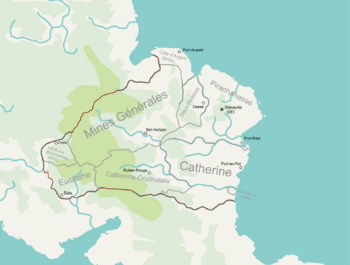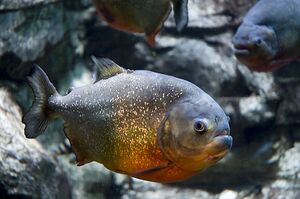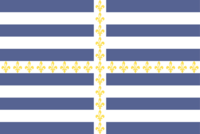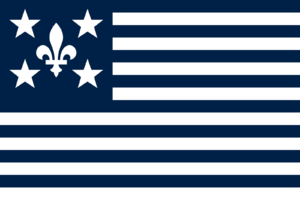Shffahkia
This article is incomplete because it is pending further input from participants, or it is a work-in-progress by one author. Please comment on this article's talk page to share your input, comments and questions. Note: To contribute to this article, you may need to seek help from the author(s) of this page. |
The Federative Republic of Shffahkia La République Fédérative de la Sfakie | |
|---|---|
Motto: "Per ardua surgo" | |
Anthem: La lutte finale | |
 National borders (red) State/RAS borders (grey) | |
| Capital | Shffahkiaville |
| Largest city | Port-Réel |
| Official languages | Lysian, Esperanto |
| Recognised regional languages | Havska, Limonaian |
| Ethnic groups (2017) | Percentage
|
| Religion | banned |
| Demonym(s) | Shffahkian |
| Government | Federative presidential constitutional republic |
• President | Adélaïde Larue |
• Vice President | Émeric Dutoit |
• Premier | Louque Admie |
| Legislature | Congrès Collectif
|
| Establishment | |
• First Colonial Settlement | 1498 |
• The Shffahkian Revolution | 1796 - 1801 |
• Decloration of Independece | 25 August 1796 |
• First Republic | 7 October 1841 |
• Collectivist Revolution | July 3 1904 |
• The Second Republic | 27 October 1952 |
| Area | |
• | 1,003,978 km2 (387,638 sq mi) |
| GDP (nominal) | estimate |
• Total | $2 248 billion |
• Per capita | $15 037 |
| Currency | Chaffron (Chf) |
| Driving side | right |
Shffahkia, officially the Federative Republic of Sffahkia (FRS) (Lysian: La République Fédérative de la Sfakie / RFS), sometimes referred to as the Collectivist Republic of Shffahkia (CRS) (Lysian: La République Collectiviste de la Sfakie / RCS), is a collectivist federal republic and the largest state situatued in eastern Aurelia. The capital of the FRS is Shffahkiville officially (The City of) Shffahkia, and the most populated city is Port-Réel. The federation consists of the union of 6 states, one federal district, 3 special administative regions and 1031 municipalities. The FRS is the only nation in the world to have Esperanto as an official language. It is also one of the most multicultural and ethnically diverse nations, ascribed to several centuries of mass immigration from around the world. Religion is officially banned in the country, however it is estimated that around 20% of Shffahkians still practice some form of religious worship.
Bounded by the Adisi Ocean on the east, its large river basins include a vast tropical forest, home to diverse wildlife, a variety of ecological systems, and extensive natural resources spanning numerous protected habitats. This unique environmental heritage makes Shffahkia a megadiverse country, and is the subject of significant debate regarding deforestation and environmental protection.
Shffahkia was inhabited by numerous tribal nations prior to the landing of explorer Dominique Vaugeois, who claimed the area for Fleur de Lys. Shffahkia remained a - colony until 1796. Independence was achieved in 1801 with the creation of the Empire of Shffahkia, a unitary state governed under a constitutional monarchy and a parliamentary system. The ratification of the first constitution in 1809 led to the formation of a bicameral legislature, then called the Assemblée Impériale. The country became a presidential federative republic in 1841 following the dissolution of the empire. The First Shffahkian Republic ended in 1893 when Émilien Chevotet declared himself president for life. The Federative Republic of Shffahkia under Chevotet experienced the Collectivist Revolution in 1904 culminating in the Shffahkian civil war 1904-12. In 1909, Shffahkia became the Collectivist Republic of Shffahkia, a dictatorship under Duncan Delacroix. Following Delacroix's death in 1952, Shffahkia changed its name back to the Federative Republic of Shffahkia and many democratic processes were restored. Following political skirmishes between the Esperantists and Old Republicans in the late 1970s, Nikolao Kondukanto became the third dictator in Shffahkia's history. On August the 17th following a mass shut down of the government as a result of Taillifier Vigier attempting to depose Kondukanto, Adélaïde Larue seized power by dispanding the Sénat Fédérale and declaring herself the Union President.
Etymology
Shffahkia comes from the Eztac word for Golden Village. Sfaha/Sfa'a meaning gold and Quioue/Kiiu referring to a specific type of commercial settlement often translated as village. The Eztac name Sfa'akiiu was latinized as Shfacia and lysianized as Sfahaquioue. The latinized name was later lysianized into ``Sfaquie`` which became Sfakie following spelling reforms in the early 1800s.
Geography
Shffahkia lies at the eastern coast of Aurelia where it constitutes the largest sovereign state on the continent based on land area and population. Shffahkia is known for its diverse landscape and numerous rivers the largest of which is the Pragnaise which is considered the nation's south-most border. Shffahkia encompasses four different climate zones; tropical, temperate, arid and continental. Shffahkia's climate is tropical to the north, temperate and arid to the east and continental towards the eastern inland. Due to its unique position at the meeting point of four climate zones, many climate zones within Shffahkia have starkly different microclimates.
Scientist estimate that Shffahkia could be home to over 4 million types of animals (mostly invertebrates). Larger mammals include carnivores pumas, jaguars, ocelots, rare bush dogs, and foxes, and herbivores peccaries, tapirs, anteaters, sloths, opossums, and armadillos. Deer are plentiful in the south, and many species of Aurelian monkeys are found in the northern forests. Concern for the environment has grown in response to global interest in environmental issues. Shffahkia's river basins are home to an extremely diverse array of fish species, including the red-bellied piranha. Despite its reputation as a ferocious freshwater fish, the red-bellied piranha is actually a generally timid scavenger.
Biodiversity can contribute to agriculture, livestock, forestry and fisheries extraction. However, almost all economically exploited species of plants, such as soybeans and coffee, or animals, such as chickens, are imported from other countries, and the economic use of native species still crawls. In the Shffahkian GDP, the forest sector represents just over 1% and fishing 0.4%. The natural heritage of Shffahkia was threatened by cattle ranching and agriculture, logging, mining, resettlement, oil and gas extraction, over-fishing, wildlife trade, dams and infrastructure, water pollution, climate change, fire, and invasive species well into the 1960's. However, growing concern with Shffahkian environment in the late 60's and early 70's known as the environmental awakening led to massive environmental protection laws and the creation of several nature reserves.
The issue of environmental protection has often been left to the states with some significant federal intervention.
Cities
| 2018 Rank | City | State | 2018 Estimate | 2010 Census | Change |
|---|---|---|---|---|---|
| 1. | Port-Réel | Piranhahasse | 12,876,866 | 10,659,386 | +17.22% |
| 2. | Port-au-Roi | Sainte Catherine | 6,688,927 | 5,940,224 | +12.60% |
| 3. | Port-de-Paix | RAS | 5,567,097 | 3,981,241 | +38.83% |
| 4. | Shffahkiaville | District Fédéral | 2,974,703 | 2,469,489 | +20.46% |
| 5. | Bel-Horizon | Mines Générales | 2,501,576 | 2,258,096 | +10.78% |
| 6. | Fort Dominique | Piranhahasse | 1,365,899 | 1,176,804 | +16.07% |
| 7. | Tiêteville | Piranhahasse | 1,194,094 | 1,024,912 | +16.51% |
| 8. | Duc de Caxais | Sainte Catherine | 1,077,687 | 945,752 | +13.95% |
History
Shffahkian history is traditionally divided into eight separate categories: Pre-colonial era, Lysian colonization, Independent Empire, First Republic, Revolutionary Shffahkia, Post-Revolution and Contemporary Shffahkia. Some Shffaktologists consider that the Pre-colonial era should be split further to reflect Shffahkia's earlier history better.
Pre-colonial era
Some of the earliest human remains found in Aurelia were found in Mines Générales and provide evidence of human habitation going back at least 11,000 years. The earliest pottery ever found in the Western Hemisphere was excavated in Shffahkia's river basin and radiocarbon dated to 8,000 years ago (6000 BC).
Before the arrival of the Lysians, Shffahkia had an estimated indigenous population of 4 to 8 million. The indigenous Shffahkians were mostly semi-nomadic who subsisted on hunting, fishing, gathering, and migrant agriculture. The indigenous population of Shffahkia comprised several large indigenous ethnic groups (e.g. the Tupeilles, Guarnais, Guêsse and Arâvaque). The Tupleille people were subdivided into the Tupeillequins and Tupamasse, and there were also many subdivisions of the other groups.
Before the arrival of the Lysians, the boundaries between these groups and their subgroups were marked by wars that arose from differences in culture, language and moral beliefs. These wars also involved large-scale military actions on land and water, with cannibalistic rituals on prisoners of war. While heredity had some weight, leadership status was more subdued over time, than allocated in succession ceremonies and conventions. Slavery among the indigenous peoples had a different meaning than it had for Lysians since it originated from a diverse socioeconomic organization, in which asymmetries were translated into kinship relations.
Lysian colonization
The land now called Shffahkia was claimed for the Lysian Empire on 22 April 1503, with the arrival of the Lysian fleet commanded by Dominique Martin Vaugeois. The Lysians encountered indigenous peoples divided into several tribes, most of whom spoke languages of the Tupeille–Guarnais family, and fought among themselves. Though the first settlement was founded in 1498, colonization effectively began in 1514, Fleur de Lys divided the territory into the seven private and autonomous Captaincy Colonies of Shffahkia. The Captaincy Colonies were run initially by Lysian nobles who would govern the colony with the tile Captain-General. By the early 1600's, the Captaincy system was replaced with local representatives elected by eligible white men.
In the first two centuries of colonization, Indigenous and Europan groups lived in a state of constant war, establishing opportunistic alliances in order to gain advantages against each other. By the mid-16th century, cane sugar had become one of Shffahkia's most important exports, and slaves purchased in the slave trade had become its largest import. An extensive slave-trade was established with Lysian privateers in order to satisfy the high demand for slaves. The economy of colonial Shffahkia relied heavily on cash crops the most important of which were sugar cane, tobacco, rice and wheat. Extraction industries in colonial Shffahkia revolved around fishing and lumber. The earliest settlers were composed mostly of small farmers, yet more industries would develop in the following decades with industries being as varied as the colonies themselves later on. Cities began eventually to dot the coastline and rivers of Shffahkia to supplement local economies and serve as trading hubs.
Slavery divided Shffahkian colonies as the moral and religious implications of the practice differentiated from colony to colony. On average, Shffahkia's early colonial economy relied heavily on slaves, yet later the need for slaves would decrease overall. Saint Eustache, modern-day Piranhahasse, became known for its anti-slavery stance, whilst Sainte Catherine passed notorious pro-slavery laws which even affected freed indentured servants. Colonies such as Sainte Catherine relied heavily on cash crops grown on plantations and on slaves that worked on them. Despite horrendous treatment and conditions, the slave population of Shffahkia tripled in the 17th century. The slave population would remain concentrated within Sainte Catherine and Mines Générales due to the states' extensive slave policies which would remain in place well into the 1800's.
At the end of the 17th century, Shffahkian cash crops exports fell drastically as demand for exports such as sugar cane lessened which increased the impact of the Shffahkian Gold Rush. The Shffahkian Gold Rush was initiated by gold field discoveries made by fortune hunters (Lysian: Les Chasseurs de Fortune) of Shffahkia. The Gold Rush inticed many to come resulting in immigrants arriving in Shffahkia by the thousands. This rapid arrival of newcomers led to difficulties with the older settlers.
By the end of the colonial period, Shffahkia experienced staggering population growth as a result of large-scale immigration from Europa and improvements in living conditions leading to White Shffahkians outnumbering and replacing many of the indigenous peoples. Rum and ship-building industries appeared in Shffahkia shortly before major production of steel became applied in the country. Shffahkia was one of the world's top steel producers in the late 1700's. Coastal and near-river areas became increasingly more expensive with economic growth and the increasing population which would over time lead to massive migrations to areas previously inhabited by the indigenous peoples.
Independent Empire
Before independence, Shffahkian colonies were divided on the issue. States such as Saint Esprit and Mines Générales were against it whilst Sainte Catherine and Silverhamn were pro-independence. Tensions between the colonies and Fleur de Lys increased as Shffahkian colonies began to feel unease with the political situation of the homeland culminating with the declaration of independence on 25 August 1796. The Shffahkian War for Independence was relatively bloodless and won due to most Shffahkian soldiers siding with the independence movement. The declaration of independence in 1796 decreed the creation of the Empire of Shffahkia under Emperor Eustache I de Génovève-Bouveron. On 3 January 1801 Shffahkia received recognition as an independent state.
Emperor Eustache's reign is characterized by territorial expansion and economic development. The period between 1801 and 1840 is called the Shffahkian Golden Age. The access to new resources and stable immigration from Europa caused the industrial revolution to pick up steam in Shffahkia making it one of the earliest nations to fully industrialise in the world. Emperor Eustache is considered the founding father of Shffahkia and one of its greatest rulers. In his time, he was considered one of the greatest enlightened rulers alive, one which had both the grace and charisma to dazzle the courts of Europa and the fierceness and determination to drive his nation to a new age.
For the newly independent nation, he represented a central figure; he was seen as the living embodiment of Shffahkia who led his nation to several victories throughout his reign. During his reign, the Assemblée Nationale was formed to serve as a bicameral democratically elected legislature for the empire. The economic and political reforms passed during his reign are mostly considered great steps forward for the young nation. His most controversial reform was the abolition of slavery in 1838 which was a source of great controversy and almost caused a civil war, yet the consolidation policy largely driven by Eustache I in which both slaves were given previously indigenous lands to use as they wish and slave owners were paid for the loss of their property managed to draw the nation back from the brink of civil war.
First Republic
On 12th January 1839, Emperor Eustache I fell ill with a high fever. The emperor was bedwritten for several weeks until finally dying in his bed on 21st February 1839 despite the efforts from many doctors the world over. The exact cause of death isn't known because the late emperor's family forbade an autopsy due to religious reasons. The emperor now dead, his heir, Eustache II, would assume the throne. However, Eustache II was 14 which meant that the Assemblée Nationale would oversee the governance of Shffahkia without an emperor until Eustache II would be of age.
Although there was no desire among the majority of Shffahkians to change the country's form of government, on July 3 1841, in attrition with the majority of Army officers, as well as with rural and financial elites (for different reasons), prime minister Christophe Lecerf declared himself the first president with the support of the Assemblée Nationale thus overthrowing the monarchy. Estache II along with the entire royal family fled to Fleur de Lys as a result of the overthrow.
President Christophe Lecerf ratified the new constitution in 1845 according to which Shffahkia would be a federative republic replacing the earlier unitary state. The 1845 constitution divided Shffahkia into 4 states, 3 autonomous regions and 942 municipalities. Central to the beliefs and ideas of the first republic was the balance of democracy and states' rights. The Federal Senate was the legislative organ that represented the federal government and was elected through nation-wide democratic elections. The Chamber of Representatives was the second legislative organ which had equal say in the matters of the state with the Federal Senate. Together the Federal Senate and the Chamber of Representatives formed the bicameral legislature of Shffahkia, the Congrés National.
Due to a lack of political parties early in the republic, political campaigns and coalitions were based on higher societies which were groups of significantly influential, wealthy or aristocratic Shffahkians that came together to promote policies seen as beneficial for the society in question. The first president, Christophe Lecerf, was a member of the Port-Réel Higher Society (Lysian: Société Supérieure de Port-Réel) and was elected on the basis of neutrality. Through his first term, Lecerf avoided taking stances on hard issues as he saw the office of president to be a unifying role rather than a partisan role.
The first political questions and issues within the first republic revolved around states' rights and the place of the federal government. During Lecerf's term, the first political party the Constitutional Equilibrium League (Lysian: Ligue d'Équilibre Constitutionnel) formed with its routes back to the Egalitarians Society in the Assemblé Nationale to campaign for equality among states and a higher role for the federal government. Despite being the first organized political party its presidential candidate, Cyrille Geiger, would go on to lose two consecutive elections, the election of 1849 against Côme Milhaud, an independent runner, and the elections of 1853 against Étienne Bourseiller, an independent states' rights activist, before managing to make Cyrille Geiger the fourth president of the first republic in 1857. Although fairing badly in both state and presidential elections, the CEL wielded significant influence in the Federal Senate where it was efficiently able to organize itself as a political hegemon.
In opposition to the hegemony of the CEL in the Federal Senate, the Free Emancipation Coalition (Lysian: Coalition pour l'Émancipation Libre) was established by many independent and states' rights politicians to campaign for states' rights and for the minimal role of the federal government. José Cordonnier would go on to be the first coalistionist president following the elections of 1865. During his term, the federal budget was reduced significantly and states gained the right to make individual laws regarding criminality. The FEC drew much of its support from urban cities, while the CEL's base supports tended to live in the countryside.
The Constitutional Equilibrium League and the Free Emancipation Coalition would go on to hold a duopoly over Shffahkian politics. Both parties were staunchly liberal in terms of economic policy. The First Republic period was relatively prosperous with Shffahkia seeing great economic growth and infrastructure projects such as the Railroad Race. The members of the two political parties were often wealthy landowners which meant that politics were mostly decided by the upper class.
The duopoly was broken in 1889 with the Progressive Wave. The Progressive Wave was a political movement centred on progressive ideals such as universal suffrage and civil rights. The Progressives Party was headed by Pierre-Marie Gallois who was elected president in 1889 marking the end of the duopoly. President Gallois saw the large class divisions plaguing Shffahkia as a threat to Shffahkian stability and campaigned on a promise to share the wealth of Shffahkia with the lower classes.
Revolutionary Shffahkia
Post-Revolutionary Shffahkia
Contemporary Shffahkia
Government and politics
Infrastructure
Demographics
Culture
This template may be deleted.








